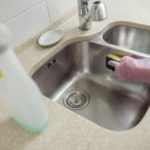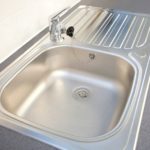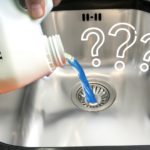Stainless steel brings a polished atmosphere to any home.
Best known for its resistance to corrosion and rust, stainless steel is often a popular choice for kitchens and bathrooms.
If you own anything made with stainless steel, you already know that it rarely 100% stainless.
Water spots and fingerprints often decorate the surfaces of kitchen appliances. Grime, dirt and dust threaten to allow rust to develop on your stainless steel.
To keep the brilliant shine that stainless steel is known for takes a little bit of elbow grease and some specific cleaning techniques.
By adhering to the steps outlined below, you can clean and maintain stainless steel appliances for years to come.
Mistakes to Avoid with Stainless Steel
Before you do anything to your stainless steel, you need to know what not to do.
Some popular products used for cleaning can damage stainless steel countertops, sinks and appliances.
These are the techniques and products you should avoid:
- DO NOT use excessively hard water as it may leave rust stains and spots.
- DO NOT use chlorine bleach or any product with it as an ingredient.
- DO NOT use highly abrasive scrubbers, steel brushes or steel wool as they will cause scratches and may leave small particle residue that will rust.
- DO NOT use oven cleaners.
- DO NOT clean when hot or warm, wait until cool to the touch to avoid damage.
- DO NOT use cleaners with an abrasive texture.
The Right Way to Clean Stainless Steel
While the list of DO NOTs may make cleaning and maintaining stainless steel seem intimidating, it really is quite easy once you know how.
Keep the DO NOTs in mind whenever you clean stainless steel but do not let them overwhelm you. Read on to learn how to do it right.
Go with the grain
The first thing you need to understand about stainless steel is that it has a grain just like some fabrics and wood.
In order to properly maintain it, you need to know how to recognize the direction of that grain.
If you look closely, there are slight striations on the surface of stainless steel. That is the grain. Keep in mind that any knobs or handles attached to an appliance may have a separate grain.
While you will not destroy an appliance by cleaning it against the grain, it won’t really get clean.
In fact, wiping against the grain will allow grime and cleaning residue to get deeper into the little crevices that comprise the grain.
This may leave your stainless steel vulnerable to corrosion and will undoubtedly dull the shine.
Follow the owner’s manual
You should also pay close attention to the owner’s manual that comes with any stainless-steel appliance you own.
These will often have specific instructions for maintaining and cleaning that particular item. Follow the care instructions to the letter.
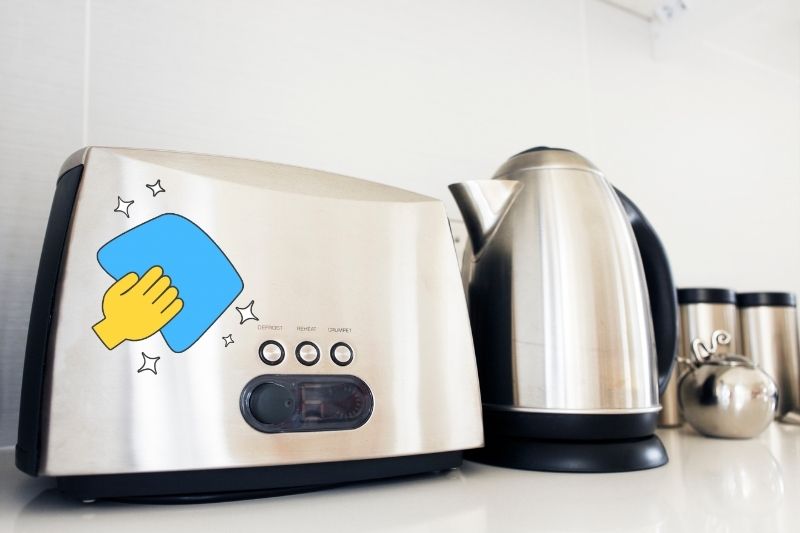
Products for Cleaning Brushed Stainless Steel
Plain water (for basic spills)
Plain water will do just fine for basic clean up like wiping up spills or small stains. You can also use mineral or deionized water for this, but it is not necessary.
Make sure that you use a soft rag that won’t leave any residue like paper towels tend to do.
Microfibre cloths are an exceptional choice as they won’t leave anything behind, and they are highly absorbent.
Remember to wipe in the direction of the grain to avoid marring the surface. Also, be sure to wipe the stainless steel down with clean clear water after the cleanup to get any residual debris.
Professional products
There are several products specifically made for cleaning stainless steel on the market now.
While some of these may be expensive, they are designed to meet all the needs of brushed stainless-steel surfaces.
Other commercial cleaning products can also be used on stainless steel. Glass cleaner with ammonia works well on these surfaces but should be followed with water.
Simple and homemade solutions
Probably the simplest way to keep your brushed stainless-steel shining brightly is to wipe it down with soapy water whenever you do the dishes. Just make sure that any soap is wiped off after you are done.
You can also use vinegar as a natural cleaning solution for brushed stainless steel.
Keeping a spray bottle of white vinegar can make this simple and quick. Just spray your surfaces with the vinegar and wipe with a soft cloth.
For tough stains like coffee or hard water marks, simple bicarbonate of soda will get the job done. Using a soft rag dampened with warm water, scrub the stain gently with the baking soda.
Wipe away any excess and give it a final wipe down with plain water. A paste made of dish soap and baking soda soap will also work well on stubborn marks.
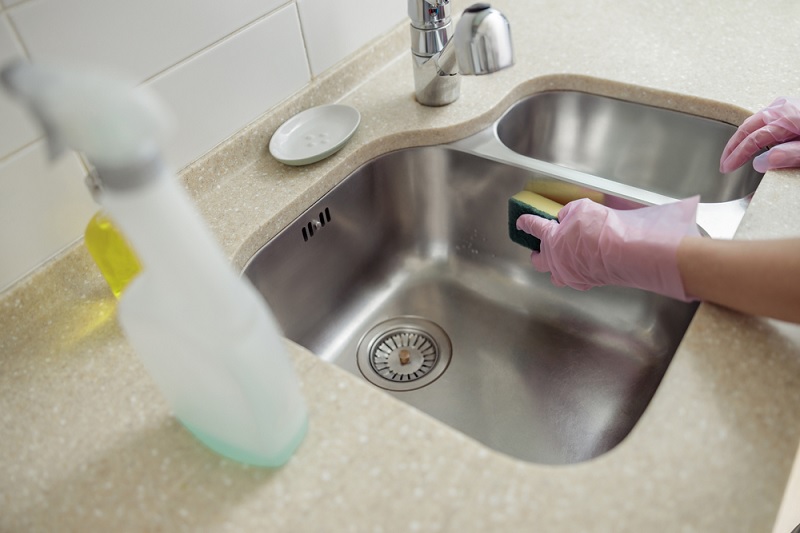
Maintaining Stainless Steel
Regardless of what you use to clean your brushed stainless-steel surfaces, the final step is to always rinse with water and dry completely.
Any product left sitting on the surface of stainless steel will cause damage over time. Even water will leave water stains that dull the finish and make your surfaces look dirty.
Don’t forget to polish that brushed stainless steel from time to time as well.
Nothing looks nicer than a freshly shined stainless steel appliance or countertop. You can even polish every time you clean.
Olive and mineral oils are both good choices for polishing stainless steel. They are natural and safe to use in areas where food is being prepared.
Oil not only encourages the natural luster of stainless steel to shine, but it also helps to protect the surface from environmental corrosives.
Rub the oil into the stainless steel – following the grain as always – and wipe any excess off to give your stainless steel a luxurious shine.
The Takeaway
Keeping stainless steel clean and well maintained is not difficult. Find a cleaning routine and stick to it.
The best way to maintain stainless steel surfaces in your home is consistency. With the techniques above and a little bit of hard work, your appliances, sinks, countertops and other stainless-steel surfaces can look fabulous for years to come.

In The Wash is your guide to the best laundry and cleaning products, tips and tricks. Our mission is to solve the UK’s cleaning and laundry dilemmas!

